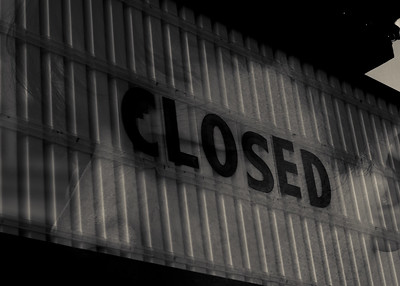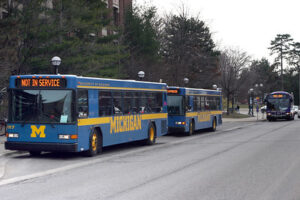Bridge Michigan ran the Michigan Community College Association’s “rebuttal” of sorts to the Business Leaders for Michigan report, which the group released last week. I’m still not clear on what BLM hoped to accomplish with the report, but the MCCA’s position also misses the mark when it comes to quantifying the successes and shortcomings of Michigan community colleges.
No one disputes the fact that enrollment has dropped by a lot. So much so that some Michigan community colleges will likely face an existential question before the end of the decade if they cannot reverse enrollment declines.
How bad is the problem? Enrollment at each Michigan community college peaked at a different time. Based on enrollment figures the colleges themselves report each year, the enrollment decline from each college’s peak looks like this:
| Institution | Peak Enrollment | Year | Current Enrollment | Change | Enrollment loss |
|---|---|---|---|---|---|
| Kellogg Community College | 14,648 | 2010 | 5,335 | -9,313 | -63.58 |
| Mott Community College | 19,113 | 2008 | 7,479 | -11,634 | -60.87 |
| Lansing Community College | 34,067 | 2007 | 14,739 | -19,328 | -56.74 |
| Wayne County Community College District | 34,698 | 2011 | 15,130 | -19,568 | -56.40 |
| Montcalm Community College | 3,840 | 2008 | 1,868 | -1,972 | -51.35 |
| Southwestern Michigan College | 4,402 | 2011 | 2,185 | -2,217 | -50.36 |
| Jackson College | 11,130 | 2010 | 5,559 | -5,571 | -50.05 |
| Monroe County Community College | 6,508 | 2010 | 3,259 | -3,249 | -49.92 |
| Oakland Community College | 46,592 | 2009 | 23,708 | -22,884 | -49.12 |
| Macomb Community College | 47,490 | 2007 | 24,180 | -23,310 | -49.08 |
| North Central Michigan College | 4,510 | 2010 | 2,347 | -2,163 | -47.96 |
| Mid Michigan College | 7,585 | 2011 | 3,983 | -3,602 | -47.49 |
| Glen Oaks Community College | 2,833 | 2009 | 1,506 | -1,327 | -46.84 |
| Kalamazoo Valley Community College | 18,322 | 2010 | 10,128 | -8,194 | -44.72 |
| Delta College | 17,115 | 2010 | 9,738 | -7,377 | -43.10 |
| Schoolcraft College | 22,809 | 2013 | 13,994 | -8,815 | -38.65 |
| Kirtland Community College | 3,193 | 2007 | 1,982 | -1,211 | -37.93 |
| Northwestern Michigan College | 6,645 | 2011 | 4,152 | -2,493 | -37.52 |
| Henry Ford College | 26,724 | 2011 | 16,811 | -9,913 | -37.09 |
| Lake Michigan College | 6,927 | 2011 | 4,377 | -2,550 | -36.81 |
| Saint Clair County Community College | 6,944 | 2011 | 4,596 | -2,348 | -33.81 |
| West Shore Community College | 2,210 | 2010 | 1,509 | -701 | -31.72 |
| Muskegon Community College | 7,503 | 2013 | 5,128 | -2,375 | -31.65 |
| Grand Rapids Community College | 25,605 | 2011 | 18,142 | -7,463 | -29.15 |
| Bay De Noc Community College | 3,215 | 2011 | 2,429 | -786 | -24.45 |
| Washtenaw Community College | 23,206 | 2010 | 18,734 | -4,472 | -19.27 |
| Alpena Community College | 2,791 | 2010 | 2,335 | -456 | -16.34 |
| Gogebic Community College | 1,568 | 2011 | 1,375 | -193 | -12.31 |
| Total | 412,193 | 226,708 | -185,485 | 55% |
Michigan Community College Association also misses the point
I ran a very similar table to this one, showing the remaining Michigan community college enrollment instead of showing the percentage drop. The point here was to determine how many empty seats Michigan’s public higher education institutions have. Michigan’s universities were operating at 17% below capacity in 2021. In the same year, Michigan community colleges were operating at 55% capacity.
I disagree with the vast majority of what appeared in the Business Leaders for Michigan report because it is largely unfair in its treatment of the data. You can’t rightly look only at full-time community college students because if you do, you’re only looking at one-third of the data. Most community college students attend school part-time. And when I say “‘most,” I mean two out of three.
So, if you look only at the graduation rate for full-time Michigan community college students, you’re going to get a different picture than if you look at the graduation rate of all students in a cohort. (That might require looking at data from the better part of a decade, though.)
Second, you can’t look at a non-degree certificate the same way you look at an associate degree. When a community college confers more certificates than degrees, you can’t hold that institution up near the top of your list of Michigan community colleges that are “almost” performing.
At the same time, I disagree with the MCCA’s rebuttal assessment of Michigan community colleges. While there is no doubt that some employers will hire community college students prior to graduation, and community colleges have vastly increased the number of dual-enrolled high school students, community college graduates experience higher rates of unemployment and job loss early in an economic downturn. Additionally, 20% of a community college’s student body also still enrolled in high school is a liability.
The real problem is the money
The real problem with Michigan community college degrees lies in the wages that employers (like those who populate the Business Leaders for Michigan) pay for community college degrees. Community colleges that cannot (or will not) weed out occupational programs that lead to low-wage jobs will be the ones who close their doors.
Over and over, community college graduates are told by Human Resources personnel (at the very same companies that the Business Leaders for Michigan operate, no less) that they can’t be paid more or fill a better-paid position because they don’t have a bachelor’s degree. The cruel hoax here is that having a bachelor’s degree does not always guarantee raises or promotions.
At the end of the day, the occupational programs differentiate community colleges from universities. Most universities don’t offer that kind of education. When community college administrators decide that university transfer programs are easier and less expensive than or otherwise preferable to occupational or vocational education, they virtually guarantee that their enrollment will decline. Not all students want to transfer to a university. Some students want skill-based occupational education. But all students want jobs that will pay their bills and support their families.
It’s not that hard. Community colleges that deliver programs that increase their graduates’ incomes will fill their classrooms. Community colleges don’t will close their doors.
Photo Credit: Geoff LMV , via Flickr























